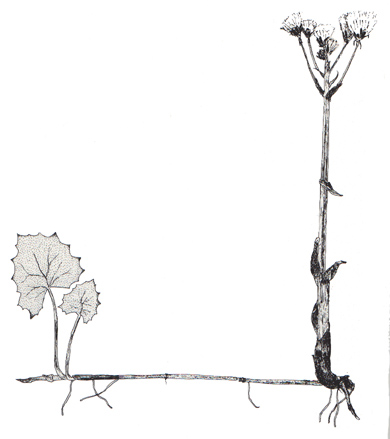

Coltsfoot
Petasites species
(Compositae)
Description:
Since coltsfoot flowers appear before the leaves they must be collected
separately. A single stalk bears one or several flowers, purple and covered
by numerous long white hairs. After the flowers have died down, the leaves sprout
and continue to grow in size throughout the summer until they are nearly a foot
(30 cm.) across. They are triangular in basic outline, but their edges are cut
into lobes and teeth. The top surface shines while underneath the color is silvery
white, the texture woolly. Coltsfoot's small white root is shallow. Petasites
frigidus, also called Tussilago frigada, has shallowly lobed, kidneyshaped basal
leaves. It is described as being from Lapland, Switzerland and Siberia. According
to Hulten its root is eaten, roasted, by the Siberian Eskimos. Petasites
hyperboreus,which hybridizes with P. frigidus,has more triangular,
deeply lobed leaves. Petasites sagittatus,
a North American species, displays triangular, arrow-shaped leaves.
These are the common Alaskan species.
Distribution:
Coltsfoot is found in bogs, meadows and wet places.
Constituents:
According to Spoerke, Tussilago farfara (a related
species), called coughwort by European herbalists, contains a bitter glycoside,
tannin, caoutchouc, a saponin, a volatile oil, a resin and pectin. Grieve says
this species contains mucilage, a little tannin, and a trace of a bitter amorphous
glucoside. The flowers also contain a phytosterol and a dihydride alcohol.
Medicinal uses:
The dried leaves or flower shoots have been used since
ancient times against persistent cough. One common name for coltsfoot is coughwort,
and tussilago means cough dispeller. For bronchitis, the dried leaves have been
smoked since the time of Pliny, who used a hollow reed for the purpose. I have
tried smoking coltsfoot leaves either by inhaling the smoke as the leaves came
into contact with charcoal, or actually smoking the crushed leaves in a pipe
alone or mixed with other herbs. The cooling effect seems to me somewhat like
the menthol in a cigarette and actually does seem to have a calming and enlarging
effect on the bronchial passages, although it is hard to recommend smoking as
a therapeutic practice when there is so much lung illness attributed to smoking.
Tanainas soak coltsfoot root in hot water and drink the tea for tuberculosis, chest troubles, sore throat, and stomach ulcers. Old-timers also drank the tea "to make the blood soft" and chewed the root for tuberculosis. (Kari) The raw or boiled root of P. speriosus (a non-Alaskan relative) is used as cough medicine by the Quileute of Washington state. (Gunther) "They also mash the root and soak it as a wash for swellings and sore eyes. The Skagit warm the leaves and lay them on parts afflicted with rheumatism." (Gunther) The root decoction was used against asthma or rheumatism. (Tobe)
The leaf or flower infusion or tincture is used against diarrhea, probably due to its astringent action. Crushed coltsfoot leaves or a decoction can be applied externally for insect bites, inflammations, general swellings, burns, erysipelas, leg ulcers, and phlebitis. (Lust)
Besides being astringent, the infusion of leaves or flowers is demulcent, emollient, expectorant, pectoral, diaphoretic, and tonic. (Kloss) It is excellent in a cough syrup with other herbs and is also good as a fomentation. Or, just moisten a cloth with coltsfoot tea and apply as a poultice to relieve the chest of phlegm.
Warning:
Heinerman cautions that large amounts and strong doses of coltsfoot tea
may produce an abortion in a pregnant woman.
Copyright © 1987 by Eleanor G. Viereck